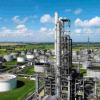Is reactor fitted with condenser? The most effective form of cooling in my experience, is to reflux the solvent to remove the heat of reaction. Depending upon its boiling point and whether you have vacuum available, this may or may not be possible; if ONCB is what I think it is, it is a very high boiler; however any toluene present would reflux at modest vacuum and provide exceptional cooling, much more effective than liquid-liquid heat transfer since you would have condensation on one side of H/X. If not possible, I noticed you have a stainless pump, if that is holding up/no corrosion issues, why not use a stainless heat exchanger which is cheaper than graphite? How is SS pump even holding up in this kind of sulfuric acid mixture?
Make sure GLR jacket is fitted with agitated nozzles on the jacket and jacket flow exceeds minimums. Also inspect jacket for corrosion. However, jacket is probably not providing that much of your overall cooling (very poor heat transfer coefficient due to thick steel + corrosion + insulating layer of glass + low velocity). Consider a Hastelloy heat exchanger or a plate & frame graphite exchanger instead of shell & tube. If you have a GLR with split pipe jacket it will work better than solid wall jacket for cooling.
Since it's already running, obtain empirical data rather than theoretical heat of reaction. Shut off the cooling for a minute or two, and feeds, and monitor empirical temperature rise (Delta T). Then calculate heat using Q=m*CP*Delta T using CP = composition weighted heat capacity of reactor, m=mass of charge. This will tell you how much heat you must remove to maintain temperature. Do this at beginning or whenever rate is maximum.
Next measure flow rate, inlet outlet temperatures on process side or brine side of H/X and solve Q = m*CP*Delta T using m = mass flow rate through HX and Delta T = temp. change across exchanger. Then solve for U using that Q. Consult with manufacturer if this 'U' is reasonable.
Consider pre-chilling reactants. Presumably you have 'stir out' time at end of reaction and 'transfer time' to pump down reactor and other downtime (weekends, etc). During such times, use the storage tank (H2SO4, OCNB) transfer pumps, to instead recirculate those tanks through a small heat exchanger, back to storage tanks, or insert cooling coils in feed tanks. This will also provide a more uniform load on your chiller so you don't 'shock' it with surge loads. Alternately with creative piping it may be possible to use the recirculation exchanger for such prechilling (i.e. whenever reaction isn't running or when it is being pumped down/out).
As for pumping rates, report back what the approach temperature is between brine inlet temp & process outlet temperature. That will give some clue whether you need more area, or a higher pumping rate. It may also make sense to look at the number of exchanger passes and pressure drop.
Edited by fseipel, 22 September 2013 - 03:38 PM.

 FB
FB












